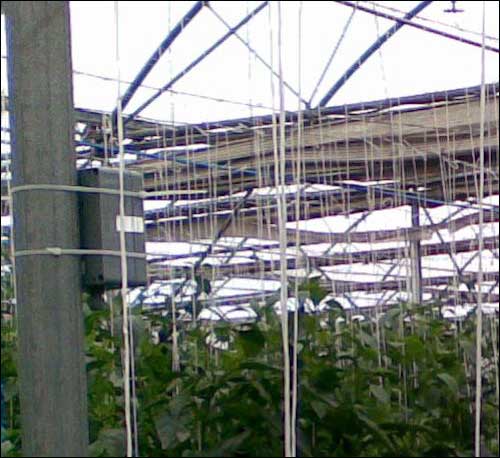Norcal Harvesting, a strawberry grower in Oxnard, Calif., is installing a wireless sensor system that will enable it to track the conditions of its plants in real time. The company will be able to see the data on a Web portal, and to design the system to automatically trigger such actions as watering or changing the temperature, based on the conditions of the air and soil in which the plants grow.
The system was developed by ClimateMinder. Initially a U.S.-based firm, ClimateMinder has been operating in Turkey under the name Kodalfa for the past two years. Kodalfa is now returning to the United States, in partnership with mobile solutions company Partners 1993, which is taking a minority stake in ClimateMinder, with investments in the form of cash and software-development services.

The technology was developed to help growers better manage the conditions of their crops, says Bulut Ersavas, the CEO of ClimateMinder and Kodalfa, and has been in use by approximately 200 greenhouses in Turkey since the company’s 2007 launch. The system has also been installed at a Turkish poultry farm, a tobacco storage facility and cold-storage warehouses. In addition, Ersavas says, his company is investigating the possibility of providing the system to golf courses, in order to help them track the amount of watering that has been done, as well as whether the greens have been adequately irrigated.
Norcal Harvesting’s wireless sensor network will be installed by GreenArch, a California-based agriculture solutions company, says Mike Almasri, the company’s product manager. “With the agriculture industry, our mission is to think outside of the box,” he says, adding that GreenArch offers environmentally sustainable solutions that could, for instance, reduce the water consumption for growers in water-scarce parts of the country, like California.
When Almasri discovered the ClimateMinder solution, he says, he took the technology to the University of California at Davis—where he is presently working on his Ph.D. degree—and experimented with the nodes and central reading unit in a university greenhouse. “The system performed very well,” Almasri says. As a result, GreenArch is deploying the system this month for Norcal Harvesting, and intends to install it in several California greenhouses in the coming months.
Norcal will monitor the amount of salt in the soil (to assess the fertilizer level) by using electric conductivity sensors, as well as measuring the soil’s water content. The company is initially deploying the system in two fields, Almasri says; assuming the success of that deployment, it plans to expand to the rest of its fields as well.
The technology features nodes that contain 2.4 GHz active RFID tags complying with the 802.15.4 ZigBee standard. Each tag can beacon its unique ID number, as well as sensor data, at any pre-set rate, at a distance of up to 250 meters (820 feet). The tag transmission is picked up and forwarded by other tags in the vicinity, then is routed to a central reader unit that captures the ID numbers of the nodes, sensor data and date and time, and transmits that information to ClimateMinder’s Web-based server via a GPRS cellular connection. End users can input a user name and password to access a Web site that displays real-time data regarding the conditions of the particular fields or greenhouses they are monitoring.
The central reader unit, which includes relays that act as power switches, can also be connected directly to equipment such as sprinklers, heaters or cooling units. If the conditions reach a specified threshold—such as sufficiently cold for frost damage, or too dry—the central unit can immediately turn on the appropriate equipment to take corrective action.
Each node is wired to a variety of sensors based on the end user’s needs. In some cases, air and soil temperatures are measured, as well as humidity, carbon dioxide and UV radiation levels. The nodes can then be placed on a bench or ground near a plant, and the sensors wired to those nodes can be situated near the plant or inserted into the ground.
The ClimateMinder server software sends alerts to users if a threshold—such as freezing temperatures—has been reached, and the user continues to receive e-mails until he or she responds.
Many greenhouses are currently monitoring their air and soil conditions based on wired sensors, Almasri says, but that requires running hundreds of feet of wires, which can be cumbersome and expensive. “The best value of this system,” he notes, “is it allows you to control the environment without wires.” The software also enables users to sign into their site on ClimateMinder by using their cell phones, and to view information related to their fields on the mobile phone screen.
Users pay a monthly fee that varies according to installation size. Because growers in different parts of the world have different concerns—such as temperature fluctuation, watering or salt issues—the system is designed to be flexible.
In Turkey, the system is being employed by a variety of greenhouses and nurseries. Has Nursery, in the Turkish city of Antalya, has been monitoring the temperature and humidity of its watermelon plants for the past six months. During the winter of 2008-09, the plants suffered temperature-related damage even though the managers had expected conditions to be sufficiently warm. “One day, I stayed at the nursery and I saw some dropping of temperature during the night,” says Hande Saganak, the nursery’s production manager. “But, of course, I wouldn’t be able to stay every night at the nursery, so I realized I needed a system such as ClimateMinder that could measure temperature and humidity very often, and could give alarm if something was wrong.”
Has Nursery installed a system consisting of five sensor nodes and one central base station. “The first week,” Saganak says, “we could not sleep all night because of the alarms. The problem was bigger than we thought, but we were able to fix it easily after the ClimateMinder system.”

